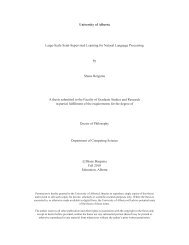The high altitude wildlife areas of western Arunachal Pradesh
The high altitude wildlife areas of western Arunachal Pradesh
The high altitude wildlife areas of western Arunachal Pradesh
Create successful ePaper yourself
Turn your PDF publications into a flip-book with our unique Google optimized e-Paper software.
<strong>The</strong> High Altitude Wildlife <strong>of</strong> Western<br />
<strong>Arunachal</strong> <strong>Pradesh</strong>: A Survey Report<br />
Abstract<br />
<strong>The</strong> <strong>high</strong> <strong>altitude</strong> <strong>wildlife</strong> <strong>of</strong> <strong>Arunachal</strong> <strong>Pradesh</strong>, located in the Eastern Himalaya<br />
biodiversity hotspot, has remained unexplored and unprotected. Between August and<br />
October, 2003, we undertook a biological expedition in the <strong>high</strong> <strong>altitude</strong>s (> 3000 m)<br />
<strong>of</strong> Tawang and West Kameng Districts <strong>of</strong> Western <strong>Arunachal</strong> <strong>Pradesh</strong>, with the<br />
objective <strong>of</strong> inventorying <strong>wildlife</strong> and identifying <strong>areas</strong> for the establishment <strong>of</strong> <strong>wildlife</strong><br />
reserves. <strong>The</strong> expedition documented the occurrence <strong>of</strong> a rich mammalian species<br />
assemblage (34 species), 12 <strong>of</strong> which are <strong>of</strong> global conservation importance. Our<br />
discovery <strong>of</strong> the Chinese goral Nemorhaedus caudatus represents a new addition to the<br />
list <strong>of</strong> large mammals <strong>of</strong> the Indian sub-continent. We also recorded a primate<br />
belonging to the sinica group <strong>of</strong> the genus Macaca, which is potentially a species new<br />
to science. We recorded 150 bird species, identified 140 plant species, and prepared a<br />
preliminary description <strong>of</strong> the <strong>high</strong> <strong>altitude</strong> vegetation. We also documented peoples’<br />
dependence on natural resources (grazing, collection <strong>of</strong> timber and medicinal plants),<br />
and the threats to the region’s <strong>wildlife</strong>, including widespread hunting, and persecution<br />
<strong>of</strong> the snow leopard Uncia uncia and dhole Cuon alpinus in retaliation against livestock<br />
depredation. Preliminary vegetation maps were prepared using field data in<br />
conjunction with satellite imageries. Based on information about the <strong>wildlife</strong><br />
assemblages, extent <strong>of</strong> <strong>high</strong> <strong>altitude</strong> habitat, and levels <strong>of</strong> anthropogenic disturbance,<br />
we identify and propose an important site (815 km 2 ) for the creation <strong>of</strong> a <strong>wildlife</strong><br />
reserve. Future conservation efforts need to focus on establishing the state’s first <strong>high</strong><br />
<strong>altitude</strong> <strong>wildlife</strong> reserve, and garnering the support <strong>of</strong> indigenous people for <strong>wildlife</strong><br />
conservation through community-based programs.<br />
i

















